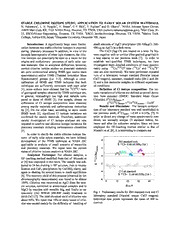
NASA Technical Reports Server (NTRS) 20100003466: Stable Chlorine Isotope Study: Application to Early Solar System Materials PDF
Preview NASA Technical Reports Server (NTRS) 20100003466: Stable Chlorine Isotope Study: Application to Early Solar System Materials
STABLE CHLORINE ISOTOPE STUDY; APPLICATION TO EARLY SOLAR SYSTEM MATERIALS. 1 1 1 N. Nakamura , L. E. Nyquist , Y. Reese 2 C-Y Shih3, T. Fujitani4 and O. Okano5. NASA Johnson Space Center, , ARES Mail Code KR, 2101 NASA Pkwy, Houston, TX 77058, USA ([email protected] ); 2Mail Code JE- 23, ESCG/Muniz Engineering, Houston, TX 77058. 3ESCG Jacobs-Sverdrup, Houston, TX 77058. 4Marine Tech. 5 College, Ashiya 659, Japan; Okayama University, Okayama 700, Japan Introduction: A significantly large mass fractio- small amounts of AgCl precipitates (50-100µgCl; 200- nation between two stable chlorine isotopes is expected 400 µg as AgCl) in a dark room. during planetary processes In addition, in view of the The CsCl (2μ g Cl) was loaded on a wide Ta fila- isotopic heterogeneity of other light elements, the chlo- ment together with an emitter (fine-grained graphite) in rine isotopes can potentially be used as a tracer for the a way similar to our previous work [7]. In order to origins and evolutionary processes of early solar sys- establish well-qualified TIMS techniques, we have tem materials. Due to analytical difficulties, however, investigated more detailed conditions of mass spectro- 133 35,37 133 current chlorine isotope studies on planetary materials metry using Cs Cl+ ions ( Cs+ and 133Cs219F+ 2 are quite controversial among IRMS (gas source mass ions are also monitered). We have performed repeated spectrometry) and/or TIMS (Thermal Ionization Mass runs of a laboratory isotope standard (Nacalai tesque Spectrometry) groups [i.e. 1-3]. Although a cross- CsCl reagent), seawater, standard rocks (J13-2 and J13- calibration of IRMS and TIMS indicates that both 3) and a few meteorite samples in different experimen- techniques are sufficiently consistent with each other tal conditions. 37 35 [4], some authors have claimed that the Cl/ Cl ratio Definition of Cl isotope composition: The iso- of geological samples obtained by TIMS technique are, topic variations of chlorine are defined as permil devia- in general, misleadingly too high and variable com- tion from seawater (SMOC: Standard Mean Ocean 37 pared to those of IRMS [3]. For eample, almost no Chloride). δ Cl (%o) ≡ SMOC differences of Cl isotope composition were observed { [37Cl/35Cl] ∕ [37Cl/35Cl] 1}x103 Sample Seawater - among mantle materials and carbonaceous meteorites Results and Discussion: The isotopic composi- by [3]. On the other hand, according to more recent tion of our laboratory standard was well established in IRMS work [2], significant Cl isotope variations are our previous work; δ37Cl =-2.49 ± 0.21%o [7]. In SMOC confirmed for mantle materials. Therefore, additional order to detect any change of mass spectrometric con- careful investigation of Cl isotope analyses are now dition, we normally analyse Cl standard before, be- required to confirm real chlorine isotope variations for tween and after the unknown samples. Since we have planetary materials including carbonaceous chondrites employed the HF-leaching method similar to that of [5]. Musashi et al. [6], it is interesting to compare our In order to clarify the stable chlorine isotope fea- tures of early solar sytem materials, we have initiated development of the TIMS technique at NASA JSC J133 standard rock 37 applicable to analysis of small amounts of meteoritic S Cl= 0.80 ±0.30%o (1cr )- and planetary materials. We report here the current 0 2 status of chlorine isotope analysis at NASA JSC. 12% Analytical Technique: For silicate samples, a 0-0,.... 0 yyy11 ....................Y_- HF-leaching method modified from that of Musashi et U al [6] was employed in this work. The sample was sub- jected to 24 hrs shaking in HF solution, then to neutra- LO -2 CEO D 'O lization and CaF precipitation by Ca(OH) slurry, and 2 2 again to shaking for several hours to reach equilibrium -4 Cl Lab standard [6].The recovery yield of this process (obtained by ion S 37Cl= -2.49 ±0.22%o (1σ ) chromatography measurement) was found to be almost -6 100%. Chlorine was recovered as AgCl from the sam- 10 20 30 40 ple solution, converted to ammoniacal complex and to Run # MgCl by reaction with metallic Mg, and finally to ca- Fig. 1 Preliminary results for J133 standard rock and Cl tion-resin (AG 50Wx8 200-400 mesh) treatment to laboratory standard (Nacalai tesque CsCl reagent). yield CsCl [7]. The total chemical yield of chlorine was Individual data points represents the mean of 300 ra- about 90%. We noted that 10% or more losses of chlo- tios/run. rine was caused mainly by the difficulty of handling of TIMS results for the same standard rock, J133, with Musashi’s analysed by their IRMS technique. We have carried out 20 runs of J133 (5 separate loadings) togeth- er with 23 runs (4 separate loadings) of Cl standard. As shown in Fig. 1, the mean of δ37Cl (‰) = 0.80 SMOC ±0.30 (1 σ) was obtained in this work. This value is in agreement with Musashi’s (0.55 ±0.10) within 1σ er- ror. Although our J133 analyses are still limited and so contain relatively large errors, it is worth noting that both TIMS and IRMS results are in good agreement. In addition to our preliminary work on bulk chondrites [5], analyses of Allende and other carbonaceous chon- drites are now in progress. Acknowledgment: We are indebted to Charlie Galindo for ion chromatography analyses during the cource of this work. References: [1] Bonifacie M. et al. (2007) Chem Geol, 242, 187-201. [2] Bonifacie M. et al. (2008), Science 319, 1518-1520. [3] Sharp Z. D. et al. (2007), Nature 446, 1062- 1614. . [4] Godon A. et al (2004) Chem. Geol. 207, 1-12. [5] Nakamura N. et al. (2007) LPS XXXIII #1929 [6] Musashi M. et al. (1998), Anal. Chim. Acta 362 261-269. [7] Numata M. et al. (2001), Geochem. J. 35, 89-100.
